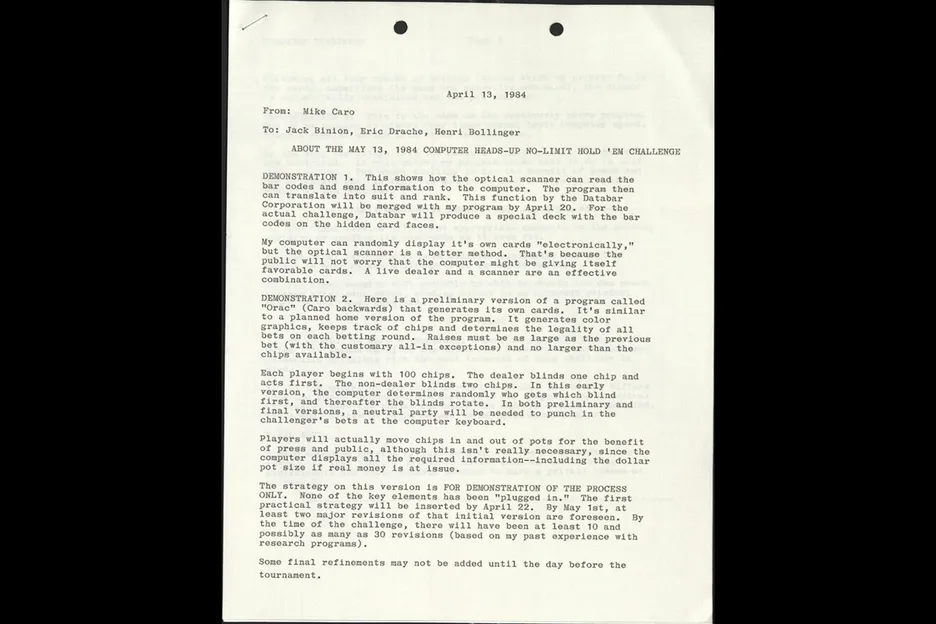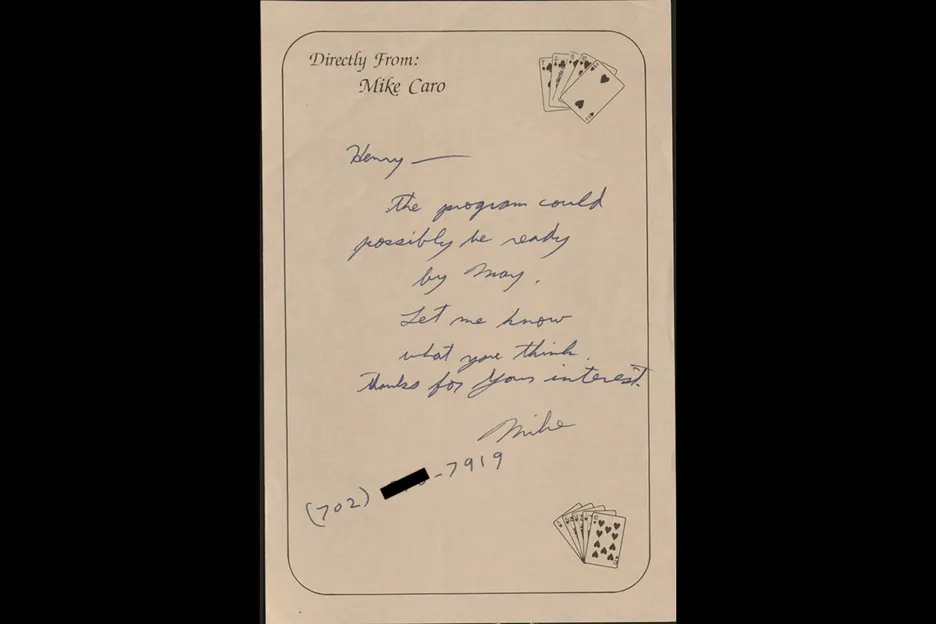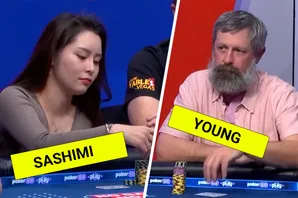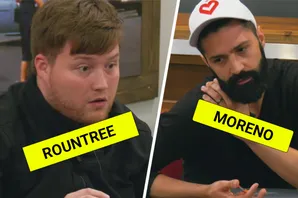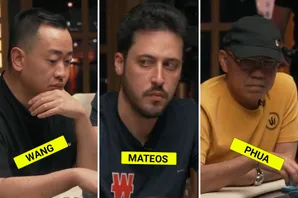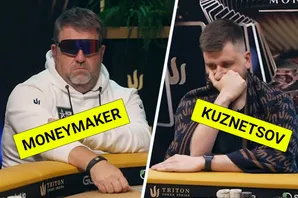In 2007, a crafty computer poker research group at the University of Alberta showed off its Polaris poker bot, a project that had been over 16 years in the making. It was a complex program run on an Apple MacBook Pro, but it only played heads-up limit hold-em.
Demonstrations against players like Phil Laak and Ali Eslami in the first Man vs. Machine Poker Championship in 2007 led to a big splash the following year at the Gaming Life Expo, where the computer played against six pro limit players in the second Man vs. Machine Poker Championship during the 2008 WSOP.
But those were not the first and second times a pro poker player took on a sophisticated computer program, as 'Mad Genius of Poker' Mike Caro would 'angrily' point out in a Bluff Magazine column that year. In none of the stories about Polaris did Caro find a single mention of Orac, his Apple II Plus computer program that played against Doyle Brunson and Tom McEvoy on the eve of the 1984 WSOP Main Event.
'Been there, done that'
A scan of “hundreds of online reports” of the 2008 computer challenge touted that a machine was finally able to compete with humans. “Been there, done that,” Caro said.
“You’ve heard about Orac, right?” Caro said at the start of his column. “Of course not! And if I don’t tell you about Orac, apparently nobody will.”
The esteemed poker media of 2008 and beyond may have forgotten about Caro’s computer challenge, but it lives on in the Special Collections stacks at UNLV, where a thick folder of letters and planning materials sits in the Binion’s casino records collection.
Caro, who was the editor of media outlets like Poker Player and Gambling Times, was already a well-established poker author and 'computer whiz' in 1984. Eager to test a poker program he had developed throughout the early eighties, he partnered with Binion’s Horseshoe to host the 1984 World’s First Computer Challenge during the 15th WSOP.
The first poker e-mail?
Caro first sent a letter in February of 1984 to Henri Bollinger, a high-powered press agent and representative of Binion’s in all public relations matters. The letter, likely a follow-up from another conversation, included the bullet points of interest in his new computer program and an example of an early form of e-mail.
“Enclosed is a copy of a file I sent by computer to Gambling Times for the May issue,” Caro writes. “You can probably get enough from this and the other articles I sent to write a good press release.” The electronic message is printed out on a fax paper, as opposed to the other letterheads of the time.
The letter explains the program in technical terms, like the fact that it would be developed on an Apple II Plus computer using the Apple Pascal programming language. Graphic choices included both two and four-color decks. A lot of the computer language was likely lost on Bollinger, but Binion’s loved a marketing gimmick, and computers were starting to break into the mainstream public consciousness in the mid-eighties.
A professional dealer would be needed, and an optical barcode scanner would be used to allow the computer to read the cards “without any human laying eyes on them.” Caro suggests that Binion’s choose which champions would play the computer.
Bollinger replies one month later with a draft of the press release. The plan was to send it to computer magazines and consumer publications to generate interest. An April 10 demonstration is also mentioned, with Jack Binion and WSOP Tournament Director Eric Drache to attend. The April 10 date would be wishful thinking.
An April 12 letter to Donna Wegner, the Sales-Promotion Director at Apple Computer, teases a May 13 date during the WSOP at Binion’s in Las Vegas. The challenge was scheduled for the night before the Main Event, and Bollinger promises more than 100 media reps in attendance from wire service reporters to network news crews.
Wegner writes back and thanks Bollinger for the interest. She would have been one of roughly ~5,000 Apple employees in 1984, and the correspondence comes just a few months after their famous Super Bowl commercial. The company now employs over 160,000 people around the world.
Demonstrations take shape
The challenge and its details start to emerge, and Caro writes to Binion, Drache, and Bollinger on April 13 with a full description of three demonstrations to be done on May 13.
The first demonstration calls for the optical scanner to read barcodes and send information to the computer. The computer translates the barcode, which they planned to hide on a special deck, into suit and rank. The program had the ability to deal cards electronically, but a live dealer and the optical scanner would be an 'effective combination' so that the public knew the computer was not giving itself favorable cards.
The second demonstration would be the planned home version of the program, which Caro called ‘Orac’ (his name backwards). It generated its own cards with color graphics and kept track of chip stacks while “determining the legality of all bets on each betting round.”
Each player started with 100 chips with blinds at 1-2, and a third person would be needed to input the live player’s bets into the computer during the public demonstration. The winner would be automatically determined by the computer after four rounds of betting and the pot was awarded accordingly.
Caro described the program’s poker strategy knowledge as being in the early stages. They planned on at least two more major revisions and up to 30 revisions in total being added and refined until the day before the challenge.
A third demonstration called for the same program to be used but running at “four times the normal Apple computer speed” with aid from a special device. “By the way, the delays that the computer takes to make its decisions are contrived. In most cases, my program knows what to do in less than a second. The short stalling is for the benefit of press and the onlookers, and, in fact, is sometimes used as a psychological weapon by the computer.”
Caro also added the classic mid-eighties touch of having the computer send messages to psyche out its human opponent. A final version would also have strategies that were designed to play against specific famous challengers, like its eventual opponents McEvoy and Brunson.
“As an artificially intelligent heads-up hold’em player, it rolled over professional-level opponents in private tests in 1983,” Caro says in his 2008 column.
Doyle and McEvoy step up
The loose ends came together, and a May 13 press memo touted the big day at Binion’s Horseshoe in downtown Las Vegas. “Mike Caro, noted poker authority and computer whiz, has developed a computer program he claims will beat the best poker players in one-on-one confrontations in no-limit hold’em, the form of poker played in the final table of the World Series of Poker which determines who the new world poker champion will be."
Accepting the challenge, according to the press memo, were Brunson, McEvoy, Puggy Pearson, ‘Amarillo Slim’ Preston, Jack Straus, and Stu Unger. Betty Carey, described as “the best high-stakes woman player,” also signed on. There would be no prize money, but the press memo promised “considerable side betting.”
In what might be an early example of the reliability of professional poker players, only Brunson and McEvoy are known to have shown up for the challenge. The program lost to McEvoy on what Caro said was an inferior hand before it split two matches against Brunson.
The first loss to Doyle was Caro’s fault, he says in his column. “Knowing Doyle Brunson as it did, I thought there was a good chance he would test the computer on the first hand by bluffing, and I had instructed Orac to make an exception and call with any pair or ace-jack or higher.” The computer’s ace-jack lost, but Brunson conceded the second match after an hour.
Caro’s program would go on to other fame, like an appearance on ABC’s Ripley’s Believe It or Not in a $500K challenge against Vegas World owner Bob Stupak. Stupak would win the challenge, but not without controversy. One of the computer’s match-winning hands was canceled out by a malfunction. “Mysteriously a cable got kicked and the computer needed to be rebooted.”
See more in the gallery:
Letters and correspondence obtained from Binion's Horseshoe Casino Records on Poker, 1960-2006. MS-00325. Special Collections and Archives, University of Nevada, Las Vegas.
Featured image courtesy of P.L./Unsplash.





